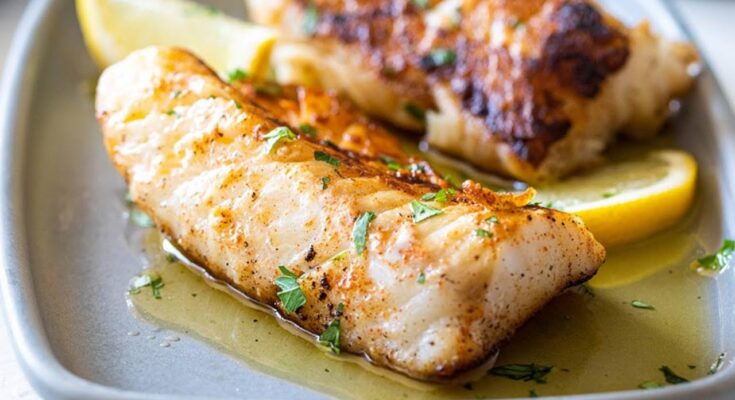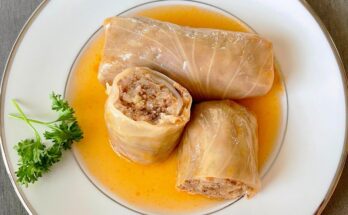Halibut Recipe: Halibut is a lean, mild-flavored fish that works well in a variety of dishes. Whether you’re a seasoned chef or someone just starting to experiment in the kitchen, cooking halibut can be a rewarding experience. It’s versatile, easy to prepare, and packs a punch of protein without being heavy on calories.
This guide walks you through step-by-step instructions to prepare the perfect halibut meal using various cooking methods.
Ingredients and Equipment
Key Ingredients for Cooking Halibut
To create a delicious halibut dish, you’ll need the following essentials:
- Fresh Halibut: Look for firm, translucent flesh that smells mildly of the ocean.
- Seasonings: Salt, pepper, garlic powder, and paprika are simple yet effective.
- Fat: Olive oil or butter for cooking.
- Acid: Lemon juice or white wine to brighten flavors.
- Optional Flavors: Fresh herbs like dill or parsley, capers, or garlic cloves.
Tip: Always choose fresh halibut over frozen when possible, but frozen works well if thawed properly.
Essential Equipment for Cooking Halibut
You’ll need the right tools to achieve restaurant-quality results:
- Non-stick or cast-iron skillet for searing.
- Baking sheet with parchment paper for baking.
- Grill with a fish basket for grilling.
- Saucepan for poaching.
- Digital meat thermometer to ensure perfect doneness.
Preparing the Halibut
How to Choose the Perfect Cut of Halibut
When shopping, you’ll come across different cuts: fillets and steaks. Fillets are thinner and more versatile, while steaks are thicker and heartier. Choose based on your preferred cooking method.
Prepping the Halibut for Cooking
- Cleaning and Trimming: Rinse the fish under cold water and pat it dry with a paper towel. Remove any small bones using fish tweezers.
- Marinating for Flavor: Combine olive oil, minced garlic, lemon zest, and fresh herbs in a small bowl. Coat the fish evenly and let it marinate for 15–30 minutes. Avoid over-marination to preserve the delicate texture.
Tips for Prepping Halibut for Various Cooking Methods
Each cooking method has unique requirements. For grilling, brush halibut with oil to prevent sticking. For poaching, cut the fish into uniform sizes for even cooking.
Cooking Methods
1. Pan-Seared Halibut Recipe (Step by Step)
- Heat a non-stick skillet with 2 tbsp of olive oil over medium-high heat.
- Season halibut with salt, pepper, and a pinch of paprika.
- Place the fish in the skillet, presentation side down.
- Sear for 3–4 minutes until golden brown. Flip and cook for another 3–4 minutes.
- Finish with a squeeze of lemon juice. Serve immediately.
2. Baked Halibut Recipe (Step by Step)
- Preheat your oven to 400°F (200°C).
- Line a baking sheet with parchment paper and place the halibut on it.
- Drizzle olive oil and season with garlic powder, salt, and pepper.
- Bake for 10–12 minutes until the fish flakes easily with a fork.
- Garnish with fresh parsley and lemon wedges.
3. Grilled Halibut Recipe (Step by Step)
- Preheat your grill to medium heat and oil the grates.
- Brush the halibut fillets with olive oil and season with salt and pepper.
- Place the fish on the grill, skin-side down. Cook for 4–5 minutes.
- Flip carefully and grill for another 3–4 minutes.
- Serve with a side of grilled vegetables.
4. Poached Halibut Recipe (Step by Step)
- Heat 2 cups of vegetable broth with a splash of white wine in a saucepan.
- Season the liquid with thyme, garlic, and a bay leaf.
- Add the halibut and simmer gently for 8–10 minutes.
- Remove the fish with a slotted spoon and serve with steamed asparagus.
5. Deep-Fried Halibut Recipe (Step by Step)
- Heat vegetable oil to 350°F (175°C) in a deep fryer or heavy pot.
- Prepare a batter with flour, baking powder, salt, and cold sparkling water.
- Dip halibut pieces into the batter and fry until golden brown (about 4–5 minutes).
- Drain on paper towels and serve with tartar sauce.
Serving Suggestions
Side Dishes to Pair with Halibut
Halibut pairs beautifully with roasted vegetables, creamy mashed potatoes, quinoa salads, or simple steamed green beans.
Sauces and Garnishes to Elevate Your Halibut Dish
Consider classic pairings like lemon-butter sauce, garlic aioli, or chimichurri. A sprinkle of fresh dill or a handful of microgreens can add a gourmet touch.
Pro Tips for Cooking Halibut
Common Mistakes to Avoid
Cooking halibut can be simple, but a few mistakes can ruin your dish. Avoid these common pitfalls:
- Overcooking: Halibut is lean and cooks quickly, so keep an eye on the time. Use a digital thermometer to check for an internal temperature of 130°F (54°C).
- Under-seasoning: Due to its mild flavor, halibut benefits from bold seasonings. Don’t be shy with spices, herbs, or sauces.
- Skipping the Sear: A good sear adds texture and flavor. Even if baking or poaching, consider giving it a quick pan-sear first.
- Not Letting It Rest: Allow cooked halibut to rest for a minute before serving to let the juices redistribute.
How to Ensure Your Halibut Stays Moist and Tender
- Cook on Medium Heat: Avoid high heat, which can dry out the fish.
- Use Marinades: A light marinade not only enhances flavor but also helps maintain moisture.
- Add a Fat Source: Butter or olive oil keeps halibut moist during cooking.
- Cook with a Lid: When baking or poaching, cover the dish to retain steam and moisture.
FAQs about Halibut Recipe
What is the best way to cook halibut to keep it moist?
Halibut can dry out quickly due to its low fat content. For a moist result, it’s best to cook halibut at a moderate temperature. Methods like baking in foil, poaching, or cooking it sous-vide can help retain its moisture. Be sure to monitor the cooking closely, as overcooking can lead to dry fish.
Can halibut be cooked from frozen?
Yes, halibut can be cooked from frozen. Increase the cooking time by about 50% compared to fresh or thawed fish. It’s important to use cooking methods that allow for even heat distribution, such as baking or broiling, to ensure it cooks through properly without becoming tough.
What are good seasonings for halibut?
Halibut has a mild flavor that pairs well with a variety of seasonings. Simple seasonings like salt, pepper, and lemon juice enhance its natural taste. For more adventurous flavors, consider using garlic, dill, or paprika. You can also marinate halibut in citrus or herb-infused oils for added flavor.
Is halibut healthy to eat?
Halibut is an excellent source of high-quality protein and omega-3 fatty acids, making it a healthy choice for a balanced diet. It’s also low in saturated fat and contains several vitamins and minerals, including selenium, phosphorus, and magnesium.
What side dishes go well with halibut?
Light and fresh side dishes complement halibut best. Consider serving it with steamed vegetables, a fresh salad, or a side of quinoa. For something heartier, pair it with roasted potatoes or a wild rice blend.
Conclusion
Halibut is a showstopper on any table, thanks to its versatility and delicate flavor. From pan-searing to grilling, each method offers a unique way to highlight this prized fish. With the right preparation, equipment, and a touch of creativity, you can master the art of cooking halibut and impress your guests with a restaurant-quality dish. Don’t be afraid to experiment with spices, sauces, and sides to make the recipe your own!



